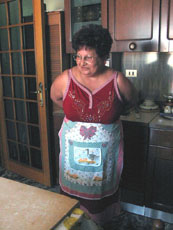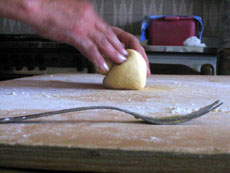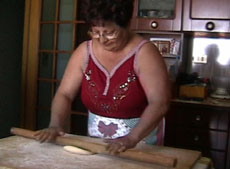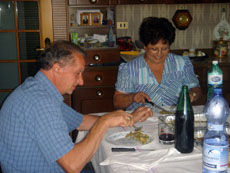Italian housewife makes dinner, memoriesBY JENNIFER L. ADAMS Camerano, Italy--Two eggs and two heaping handfuls of flour make a lot more than two servings of pasta. For Anna Roldi, these ingredients help make memories. Roldi is a casalinga, or housewife. “It is everything to me,” says Roldi, describing her role. “It is important to my family for me to be a casalinga.” |
|
|||||||||
 |
Since Roldi was 14, she helped her mother prepare meals for all sorts of occasions. Now, several decades later, Roldi still prepares these special dishes, such as tagliatelle. Although she has no children of her own, she frequently receives phone calls from her nephew, who is always asking her to make homemade pasta. Roldi offers a glimpse into the life of a casalinga, as she prepares dinner for her husband and herself one day in July. First, she grabs a thick, wooden block that still has traces of flour caked on it and places it on the table. Then, she brings out a thick rod, about the length of a baseball bat, called a mattarello, to be used as a rolling pin. Next, she takes two hands full of flour from a small bag and places them on the block. She makes a deep well in the center and adds two brown eggs. When asked why she does not use precise measurements, Roldi said after several years of experience she “has an eye for it.” She cracks the eggs on the table, drops them into the well, whisks them, and neatly mixes the flour into the eggs with a fork. |
|||||||||
Anna Roldi prepares for an evening of cooking. Photo by Lea Emery |
||||||||||
|
Watch a day in the life of Casalinga Anna (Quicktime Video) |
||||||||||
Once thick dough is formed, Roldi splashes the mixture with flour. She scoops up the excess and kneads the dough for a few minutes. Then, she uses the mattarello to flatten the dough quickly and precisely. When she finishes, she unrolls the dough and flattens a fingertip to elbow-length sheet of dough into a circle. After a final press, Roldi says, “Now we must wait.” She says homemade pasta is the one food she cannot live without. Not only does homemade pasta remind her of her mother, she says, but it also tastes good. She then leaves the room and returns with a black and white picture of her mother and father, when they were younger. She speaks of her parents with the same sense of pride with which she cooks. To her, sharing the dish with others is like sharing her parents’ legacy. After placing the picture on the table, she washes her hands and prepares the next part of the meal. Roldi takes chicken from the refrigerator, and dumps it into a pan of olive oil that is heating on the stove. She peels a fresh clove of garlic and tosses it in the pan. Next, she adds rosemary from her garden. “I picked this at noon,” she says. She adds white wine and cherry tomatoes. The chicken turns a golden brown. “The smell is not complete,” announces Roldi, as she takes a whiff of the mouthwatering aroma. She then folds the pasta into thirds and slices the roll in neat strips. She separates the noodles and sifts through them like a child playing in the sand. She then neatly places the noodles in a pan for cooking. Although Roldi claims that olive oil is the key to great Italian cuisine, one taste of this dish reveals that a casalinga like Anna Roldi cooks with heart, soul, tradition, and the flavors of the land, the most important elements of great Cameranese meals. |
||||||||||
Casalinga Anna enjoys a home-cooked meal with her husband. Photo by Lea Emery |
||||||||||
|
Home | About Camerano Project | Contact Us Arts & Entertainment | Sports | Family & Faith | Commerce | Community Life | Index Copyright ©2006 The Institute for Education in International Media |
||||||||||



